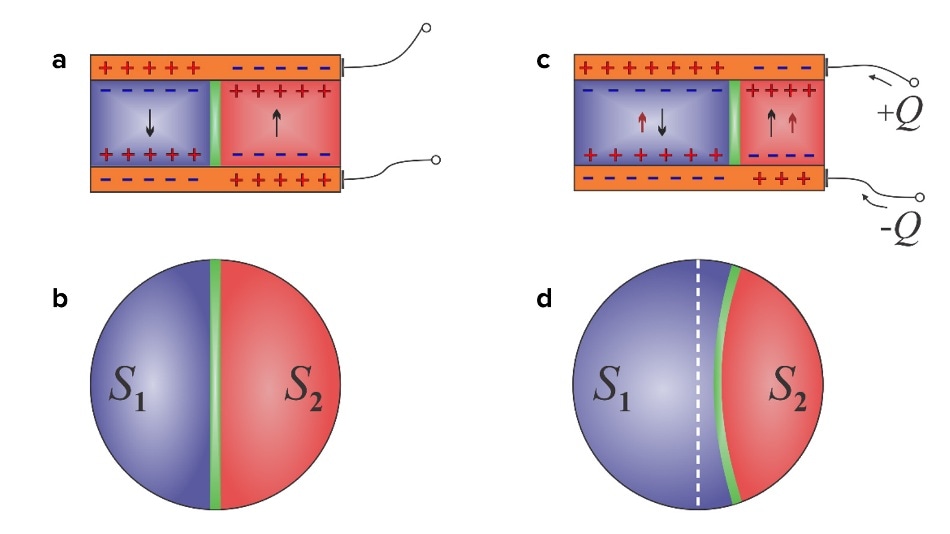Apr 9 2019
Using some physics ingenuity, researchers have developed a new method that enables small-scale redistribution of electricity. This breakthrough can pave the way for new areas of studies on more energy-efficient computing.
 This image shows the movement of the domain wall (a-c and b-d) in a capacitor when a charge is added to one side (c). The resulting redistribution of the domain wall causes a negative capacitive effect. (Image credit: Argonne National Laboratory.)
This image shows the movement of the domain wall (a-c and b-d) in a capacitor when a charge is added to one side (c). The resulting redistribution of the domain wall causes a negative capacitive effect. (Image credit: Argonne National Laboratory.)
In the latest work, scientists at the U.S. Department of Energy’s (DOE) Argonne National Laboratory, along with collaborators in Russia and France, have developed a device called permanent static “negative capacitor,” which is believed to violate physical laws until approximately 10 years ago.
Although designs that were earlier proposed for negative capacitors were able to work only on a temporary and transient basis, the latest negative capacitor concept developed by the Argonne team works as a reversible, steady-state device.
The scientists discovered that when a negative capacitor is paired in series with a positive capacitor, the voltage on the positive capacitor can be locally increased to a point greater than the overall system voltage. In this manner, electricity can be distributed to areas of a circuit needing greater voltage whilst operating the whole circuit at a lower voltage.
The objective is to get electricity where it is needed while using as little as possible in a controlled, static régime.
Valerii Vinokur, Study Corresponding Author and Materials Scientist, Argonne National Laboratory.
The electric voltage in conventional capacitors is relative to their stored electrical charge—the voltage increases when the amount of stored charge is increased. However, the opposite happens in the case of negative capacitors—that is, the voltage decreases when the amount of charge is increased. This does not violate energy conservation since the negative capacitor is a part of the larger circuit.
One way you can think about it is like having a refrigerator. Inside the refrigerator, of course, it is much colder than the outside environment, but that is because we are heating up the rest of the environment by expending energy to cool the refrigerator.
Igor Lukyanchuk, Study First Author and Scientist, University of Picardie (France).
Vinokur and his colleagues proposed a major component of the negative capacitor that involves a filling composed of a ferroelectric material, which is analogous to a magnet except that it does not have a magnetic orientation but an internal electric polarization.
In a ferroelectric nanoparticle, on one surface you will have a positive charge, and at the other surface you will have negative charges. This creates electric fields that try to depolarize the material.
Valerii Vinokur, Study Corresponding Author and Materials Scientist, Argonne National Laboratory.
When Vinokur and his colleagues divided a nanoparticle into two equivalent ferroelectric domains of opposite polarization, isolated by a boundary known as a domain wall, they successfully reduced the effect of the overall depolarizing electric field. Subsequently, they added charge to one of the ferroelectric domains and effectively changed the position of the domain wall between them. Since the nanoparticle has cylindrical nature, the domain wall started to decrease, enabling it to displace beyond the latest electric equilibrium point.
Essentially, you can think of the domain wall like a fully extended spring. When the domain wall displaces to one side because of the charge imbalance, the spring relaxes, and the released elastic energy propels it further than expected. This effect creates the static negative capacitance.
Igor Lukyanchuk, Study First Author and Scientist, University of Picardie (France).
An article based on the study titled, “Harnessing ferroelectric domains for negative capacitance,” featured in the February 26 online edition of Communications Physics. Study authors also include Anaïs Sené of the University of Picardie, and Anna Razumnaya and Yuri Tikhonov of the Southern Federal University (Russia).
The DOE’s Office of Science funded the research conducted at Argonne National Laboratory, and the European Commission’s HORIZON 2020 initiative funded the study at the collaborating institutions.